
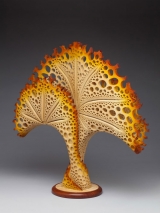
ACC artist Mark Doolittle holds a Ph.D. in biology, and it's clear that his background has inspired his sculptural woodcarvings. He's studied the aesthetics and organization of cells and tissues, and aims to translate that in his pieces. Or as he puts it, "I want the viewer to sense that my sculptural pieces ‘grew' that way rather than having been carved." He was gracious enough to elaborate on the pieces featured here:
"Ammonite Sculpture and Blooming Sculpture were carved from single blocks of Amboyna Burl (Pterocarpus Indicus), an Indonesian wood with a beautiful red heartwood and yellow-gold sapwood; no staining was used and a clear finish was applied to bring out the natural beauty of the wood. Coral Sculpture was carved from a single block of Basswood (Tilia Americana), a pale-yellow American wood that is prized for its carving properties. In finishing this piece, an airbrush was used to apply stains that emulate the resplendent colors of a living coral reef."
In short: You simply have to see Mark Doolittle's carved wood sculptures in person, and you can if you're in San Francisco this weekend. Stop by booth 419 at Fort Mason Center!
Can't get enough craft? Neither ...
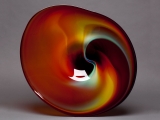
We caught up with first year ACC show artist Gerald Patterson right before the doors opened at the San Francisco show today. His glass work for the wall is extraordinarily colorful, appearing like it might even be backlit (though it's definitely not). Take a look below to hear how he got into glass and what his ACC show experience has been.
...
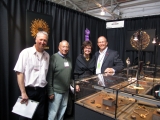
The Awards of Excellence Walking Tour is - hands down - my favorite part of every ACC Show. Everyone gathers at the Council booth, and off we go to surprise the winning artists. This year's San Francisco jurors were Mike Holmes, co-owner of Velvet da Vinci, and Ted Cohen, an exhibition designer who works with institutions such as the Museum of Craft and Design and the Museum of Craft and Folk Art. It was a supreme treat to listen to these veterans of the studio craft world as they bestowed four awards of excellence.
Here's what they had to say:
Judith Kinghorn
Kinghorn's jewelry is a "glorious combination of spectacular workmanship and beautiful design," Holmes said. "The more you look at [her pieces], the more you realize what goes into them." The men praised Kinghorn's immaculate technique and the timeless quality of her quiet, thoughtful jewelry.
Morgan Madison
Madison's kiln-formed and cold-worked glass compositions caught the jurors' attention for revitalizing, even reinventing a technique they've seen often at shows - but never like this, they stressed. Beautiful design, flawless execution. Madison's work is "a breath of fresh air," Cohen said. "It has a wonderful, free look to it."
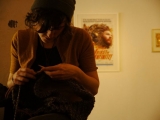
I'm not a professional craftsperson. I'm a writer and activist who has spent two years working to end mountaintop removal mining in Appalachia. Mountaintop removal is a destructive form of mining that blows off mountain peaks to get to the coal seams beneath them. It poisons waterways, destroys ecology and causes drastic health impacts in adjacent communities.
Fighting to abolish mountaintop removal is intense and heartbreaking work. Years of effort can go in to lobbying legislatures, compiling scientific evidence and staging direct action campaigns- often with no immediate results. While we've had incredible success as a movement, not being able to see how I've directly impacted the struggle can be disheartening. To stay sane, I try to remember the supportive words of friends and those beautiful moments when the anti-MTR movement has stood without compromise. But also, I craft.
My particular brand of tonic is knitting and fiber arts. Through this work, I carve out space to be alone and think through my life and ideas (most of my activist work is highly collaborative). Craft lets me slow down and not worry so much. When making something, my biggest challenges are using my materials and executing my process well. If I mess ...
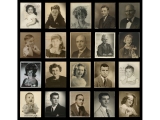
I'm digitally compulsive - digits being defined as fingers. I need to use my hands all the time. Making things centers me in the same way that training for a marathon, practicing the piano, or cultivating a garden does for others. In home economics class in junior high, we learned to make gathered skirts and crop tops. I made a dozen. When I was young and my kids were little, my expression was still craft. Seeing an item I had sewn or knitted proved I'd lived the day before-that I had accomplished something that hadn't been eaten, dirtied, or thrown away. For years I continued to knit size two toddler sweaters (using the same two patterns in different colors) while watching TV, riding in the car, and sitting through meetings. I gave them as baby presents or sold them to friends for the cost of the materials. I have 60-plus sweaters and several dozen skeins of yarn stored in boxes.
As my kids and I got older, I wanted more from my making. I was drawn into the artier side of creativity. I wanted to communicate-not just affirm-my existence. Making needed to be more than just about me and yet ...
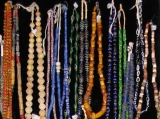
Kenya, May 1991. My husband came home from work and found me in a low chair by the window. On my lap was a tray of African beads, and in one hand I held a partly finished necklace - Ethiopian silver threaded between amber and old Venetian trade beads. The jacaranda tree outside was catching the last of the light, its froth of mauve flowers gathering a tinge of pink. The call of a Hadada ibis lingered in the air. I, who am sustained by the beauty of nature, was not moved. Instead I felt stung by nature's indifference, by the fact that this beauty continued as though nothing had changed.
Graham called out his usual greeting, knowing nothing until I spoke. My response was flat and clipped, I'm sure, as though any intonation, any lingering on a vowel, would be too painful. He crouched at my side and looked into my grief-flattened eyes and pressed his lips on my swollen eyelids, my stiff mouth.
I had learned about the accident in the morning, how a huge truck had crashed into their car on the Naivasha Road in the Rift Valley. They did not die instantly, but of their terrible wounds. ...
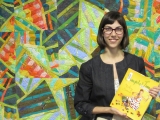
Today's interview is with Alanna Nissen, office coordinator at the American Craft Council.
What is your favorite/most-read craft book in your personal collection?
I have so many, it's impossible to pick! I've got everything from historical overviews of traditional, domestic crafts to how-to books to Amy Sedaris's new book, Simple Times. A favorite recent addition is the catalog to the Sonya Delaunay exhibition, "Color Moves," which recently closed at the Cooper Hewitt - a show I absolutely loved.
What book or magazine would you like to sneak out of the ACC Library?
I just did! I recently borrowed Becoming Judy Chicago, Gail Levin's biography of the controversial feminist artist.
What book(s) are you currently reading? Any kind of book is fine!
Besides the Judy Chicago bio, I'm also reading a collection of 1960s Batgirl comics. You really can't beat a crime-fighting librarian who sews her own superhero costumes!
What hooked you on craft? What's the first craft you remember seriously catching your eye?
I'm a bit of a jack-of-all-trades, master of none when it comes to crafts. I do fancy myself a decent knitter, and I particularly love textile related crafts. Early on I was a big fan of puff-painted ...
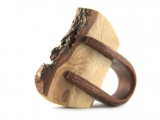
Gustav Reyes makes jewelry I can get behind. I love the curved and clean lines of his bracelets, and the live-edge on the ring looks almost Nakashima-inspired. He'll be at the Craft2Wear show at the Smithsonian in October, but in the mean time you can take a look at more of his work on his website.
Can't get enough craft? Neither can we. Heck Yes Craft is a series of visual blog posts with a simple mission: to show off amazing work. Come back every Friday for more.
...



